PONTIAC GRAND AM 1997 Owners Manual
Manufacturer: PONTIAC, Model Year: 1997, Model line: GRAND AM, Model: PONTIAC GRAND AM 1997Pages: 371, PDF Size: 18.14 MB
Page 261 of 371
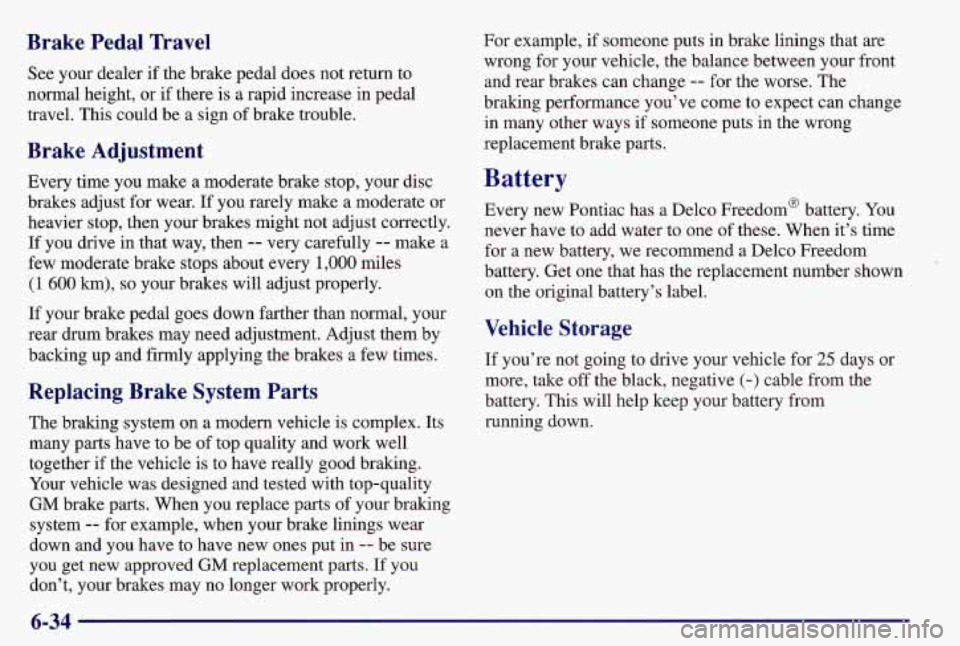
Brake Pedal Travel
See your dealer if the brake pedal does not return to
normal height, or if there is a rapid increase in pedal
travel. This could be a sign of brake trouble.
Brake Adjustment
Every time you make a moderate brake stop, your disc
brakes adjust for wear.
If you rarely make a moderate or
heavier stop, then your brakes might not adjust correctly.
If you drive in that way, then -- very carefully -- make a
few moderate brake stops about every
1,000 miles
(1 600 km), so your brakes will adjust properly.
If your brake pedal goes down farther than normal, your
rear drum brakes may need adjustment. Adjust them by
backing up and firmly applying the brakes a few times.
Replacing Brake System Parts
The braking system on a modern vehicle is complex. Its
many parts have to be of top quality and work well
together
if the vehicle is to have really good braking.
Your vehicle was designed and tested with top-quality
GM brake parts. When you replace parts of your braking
system
-- for example, when your brake linings wear
down and you have to have new ones put in
-- be sure
you get new approved
GM replacement parts. If you
don’t, your brakes may no longer work properly. For
example, if someone puts in brake linings that are
wrong for your vehicle, the balance between your front
and rear brakes can change
-- for the worse. The
braking performance you’ve come to expect can change
in many other ways if someone puts in the wrong
replacement brake parts.
Battery
Every new Pontiac has a Delco Freedom’ battery. You
never have to add water to one
of these. When it’s time
for a new battery, we recommend a Delco Freedom
battery. Get one that has the replacement number shown
on the original battery’s label.
Vehicle Storage
If you’re not going to drive your vehicle for 25 days or
more, take off the black, negative
(-) cable from the
battery. This will help keep your battery from
running down.
6-34
Page 262 of 371
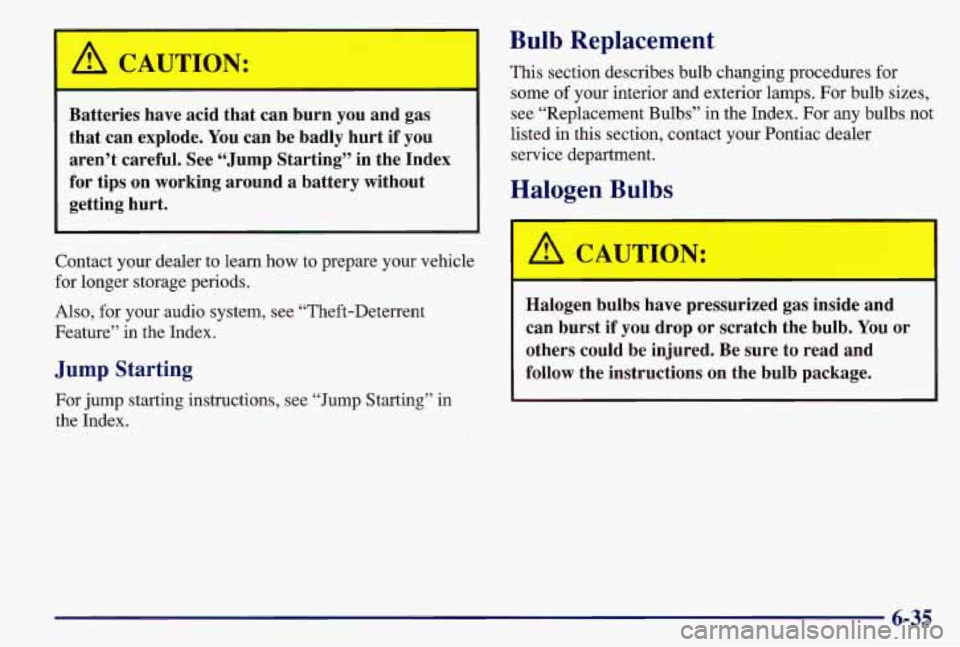
I A CAUTION:
I
Batteries have acid that can burn you and gas
that can explode.
You can be badly hurt if you
aren’t careful. See “Jump Starting” in the Index
for tips on working around
a battery without
getting hurt.
-1
Contact your dealer to learn how to prepare your vehicle
for longer storage periods.
Also, for your audio system, see “Theft-Deterrent
Feature” in the Index.
Jump Starting
For jump starting instructions, see “Jump Starting” in
the Index.
Bulb Replacement
This section describes bulb changing procedures for
some of your interior
and exterior lamps, For bulb sizes,
see “Replacement Bulbs” in the Index. For any bulbs not
listed in this section, contact your Pontiac dealer
service department.
Halogen Bulbs
LA CAUTION:
4
Halogen bulbs have pressurized gas inside and
can burst if you drop or scratch the bulb.
You or
others could be injured.
Be sure to read and
follow the instructions on the bulb package.
6-35
Page 263 of 371
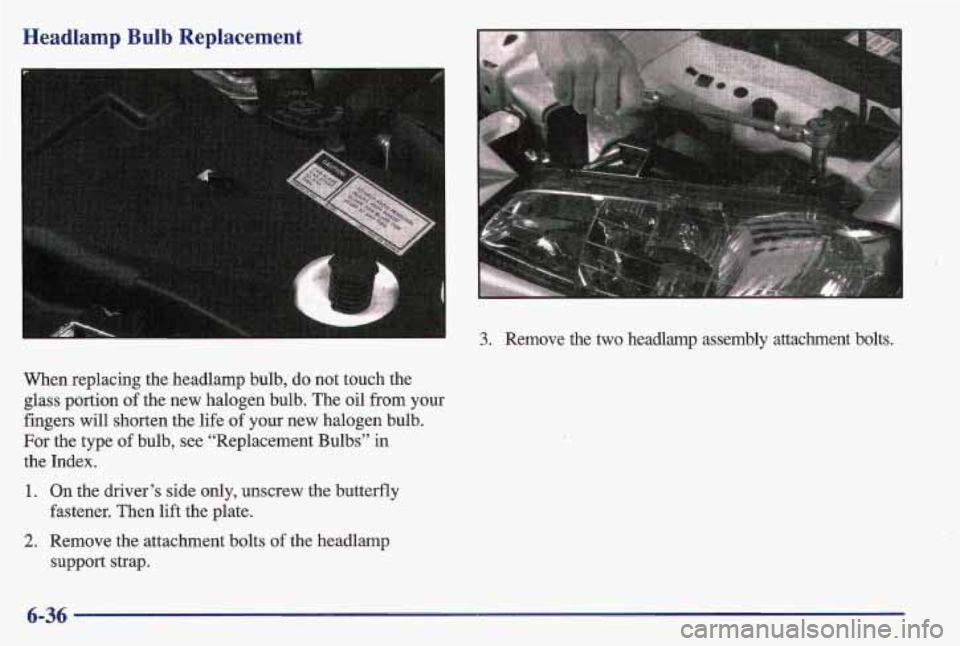
Headlamp Bulb Replacement
When replacing the headlamp bulb, do not touch the
glass portion of the new halogen bulb. The oil from your
fingers will shorten the life
of your new halogen bulb.
For the type of bulb, see “Replacement Bulbs” in
the Index.
1. On the driver’s side only, unscrew the butterfly
2. Remove the attachment bolts of the headlamp
fastener.
Then lift the plate.
support strap.
3. Remove the two headlamp assembly attachment bolts.
6-36
Page 264 of 371
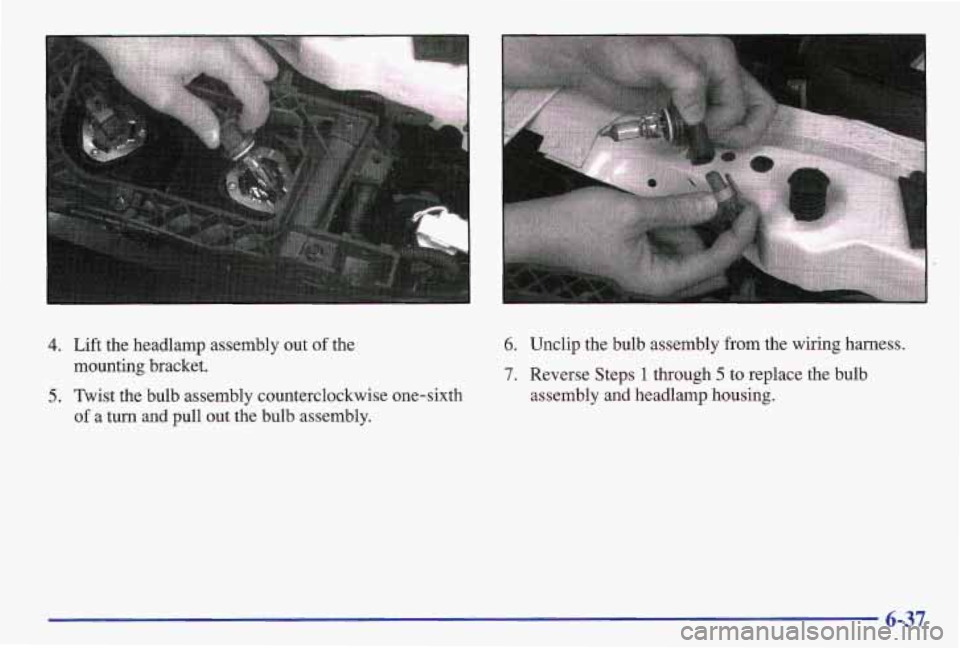
4. Lift the headlamp assembly out of the
mounting bracket.
5. Twist the bulb assembly counterclockwise one-sixth
of a turn and pull out the bulb assembly.
6. Unclip the bulb assembly from the wiring harness.
7. Reverse Steps 1 through 5 to replace the bulb
assembly and headlamp housing.
6-37
Page 265 of 371
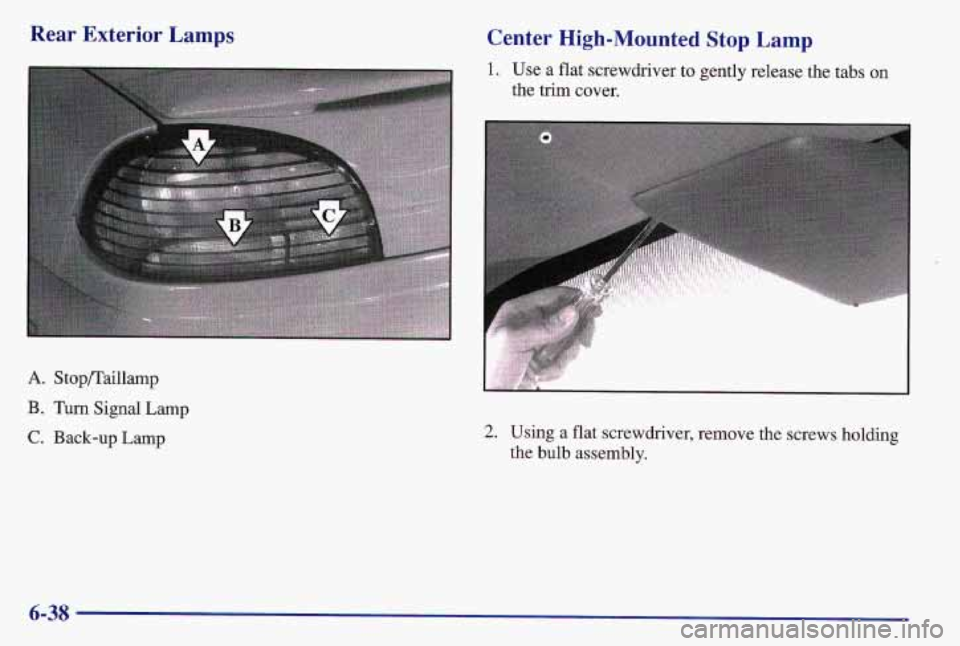
Rear Exterior Lamps
A. Stop/Taillamp
B.
Turn Signal Lamp
C. Back-up Lamp
Center High-Mounted Stop Lamp
1. Use a flat screwdriver to gently release the tabs on
the trim cover.
?. Using a flat screwdriver, remove the screws holding
the bulb assembly.
6-38
Page 266 of 371
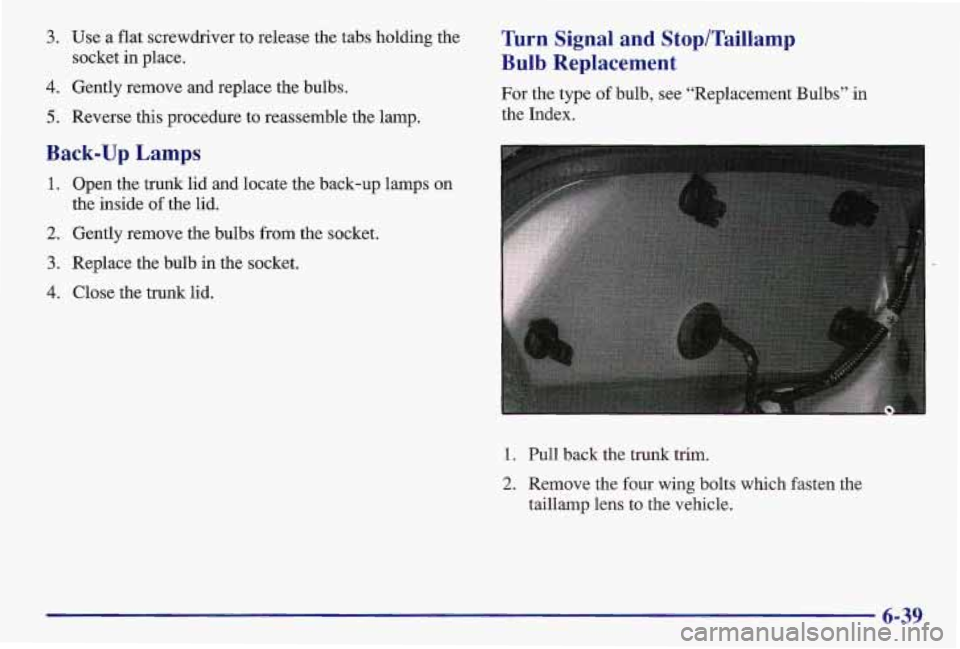
3. Use a flat screwdriver to release the tabs holding the
socket in place.
4. Gently remove and replace the bulbs.
5. Reverse this procedure to reassemble the lamp.
Turn Signal and Stop/Taillamp
Bulb Replacement
For the type of bulb, see “Replacement Bulbs” in
the Index.
Back-up Lamps
1. Open the trunk lid and locate the back-up lamps or1
2. Gently remove the bulbs from the socket.
3. Replace the bulb in the socket.
4. Close the trunk lid.
the
inside of the lid.
1. Pull back the trunk trim.
2. Remove the four wing bolts which fasten the
taillamp lens to the vehicle,
6-39
Page 267 of 371
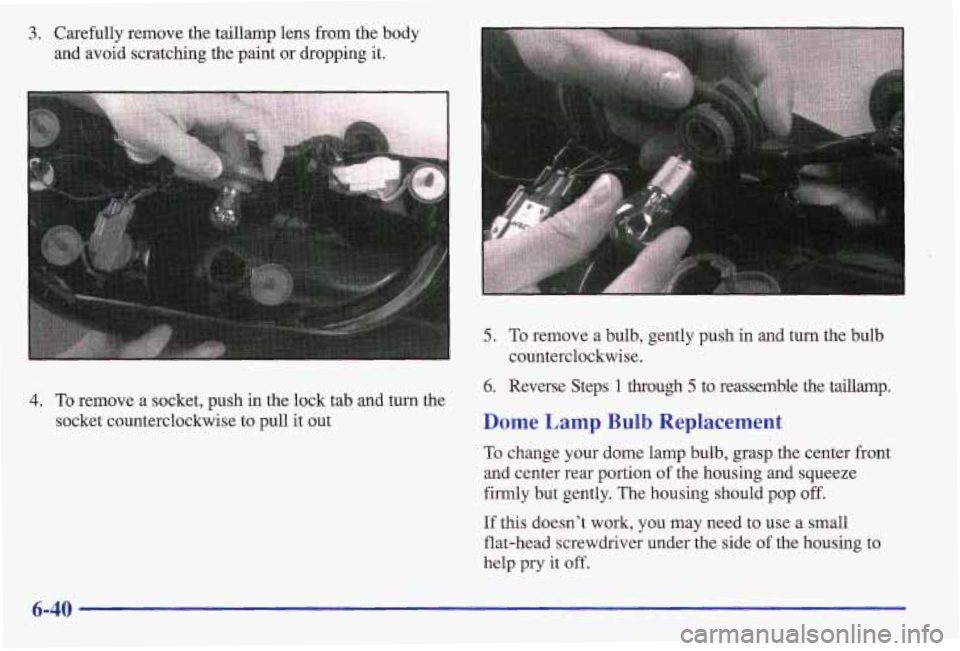
3. Carefully remove the taillamp lens from the body
and avoid scratching the paint or dropping it.
4. To remove a socket, push in the lock tab and turn the
socket counterclockwise to pull it out
5. To remove a bulb, gently push in and turn the bulb
counterclockwise.
5. Reverse Steps 1 through 5 to reassemble the taillamp.
Dome Lamp Bulb Replacement
To change your dome lamp bulb, grasp the center front
and center rear portion of the housing
and squeeze
firmly but gently. The housing should pop off.
If this doesn’t work, you may need to use a small
flat-head screwdriver under the side of the housing to
help pry
it off.
6-40
Page 268 of 371
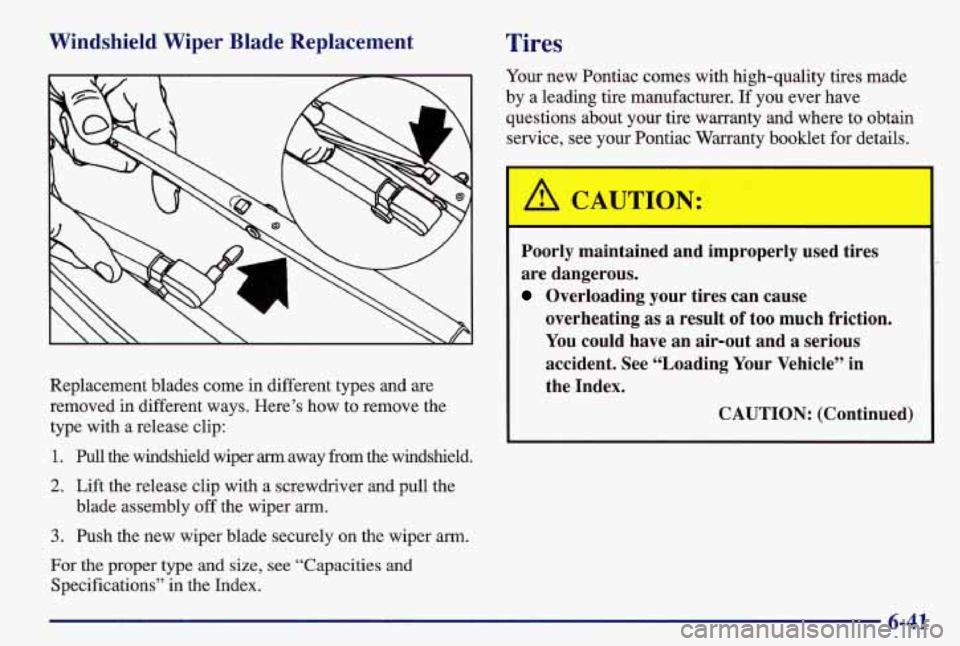
Windshield Wiper Blade Replacement
Replacement blades come in different types and are
removed in different ways. Here’s how to remove the
type with a release clip:
1. Pull the windshield wiper arm away from the windshield.
2. Lift the release clip with a screwdriver and pull the
3. Push the new wiper blade securely on the wiper arm.
blade assembly
off the wiper
arm.
For the proper type and size, see “Capacities and
Specifications” in the Index.
Tires
Your new Pontiac comes with high-quality tires made
by a leading tire manufacturer.
If you ever have
questions about your tire warranty and where to obtain service, see your Pontiac Warranty booklet for details.
6b, CAUTION:
Poorly maintained and improperly used tires
are dangerous.
Overloading your tires can cause
overheating as a result
of too much friction.
You could have an air-out and a serious
accident. See “Loading Your Vehicle” in
the Index.
CAUTION: (Continued)
6-41
Page 269 of 371
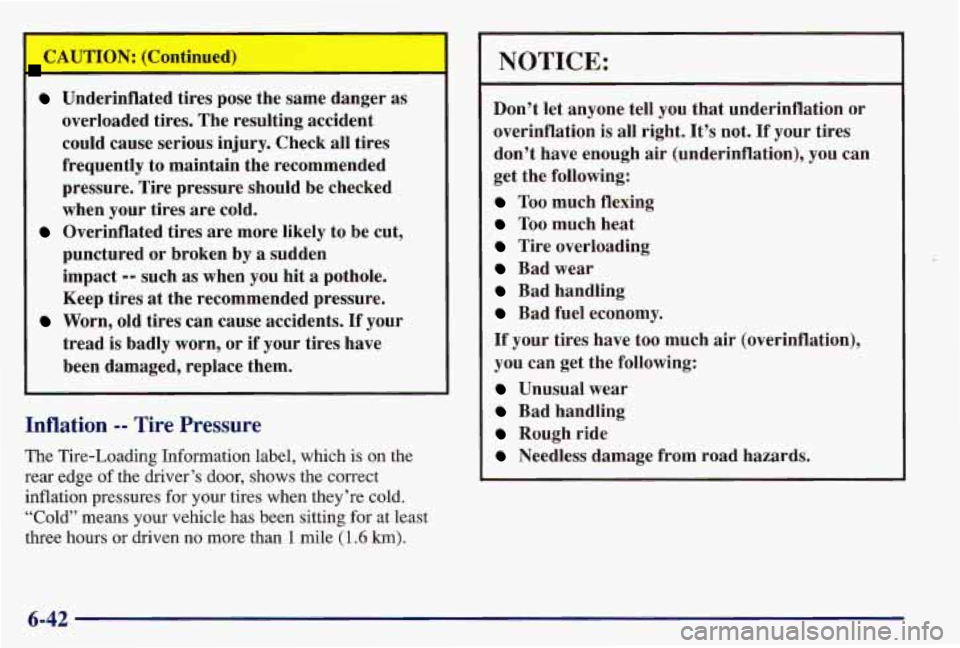
-
CAUTION: (Continued)
Underinflated tires pose the same danger as
overloaded tires. The resulting accident
could cause serious injury. Check all tires
frequently to maintain the recommended pressure. Tire pressure should be checked
when your tires are cold.
Overinflated tires are more likely to be cut,
punctured or broken by
a sudden
impact
-- such as when you hit a pothole.
Keep tires at the recommended pressure.
Worn, old tires can cause accidents. If your
tread
is badly worn, or if your tires have
been damaged, replace them.
Inflation -- Tire Pressure
The Tire-Loading Information label, which is on the
rear edge of the driver’s door, shows the correct
inflation pressures for your tires when they’re cold.
“Cold” means your vehicle has been sitting for at least
three hours or driven no more than
1 mile ( 1.6 km).
NOTICE:
~ ~~
Don’t let anyone tell you that underinflation or
overinflation is
all right. It’s not. If your tires
don’t have enough air (underinflation), you can
get the following:
Too much flexing
Too much heat
Tire overloading
Bad wear
Bad handling
Bad fuel economy.
If your tires have too much air (overinflation),
you can get the following:
Unusual wear
Bad handling
Rough ride
Needless damage from road hazards.
6-42
Page 270 of 371
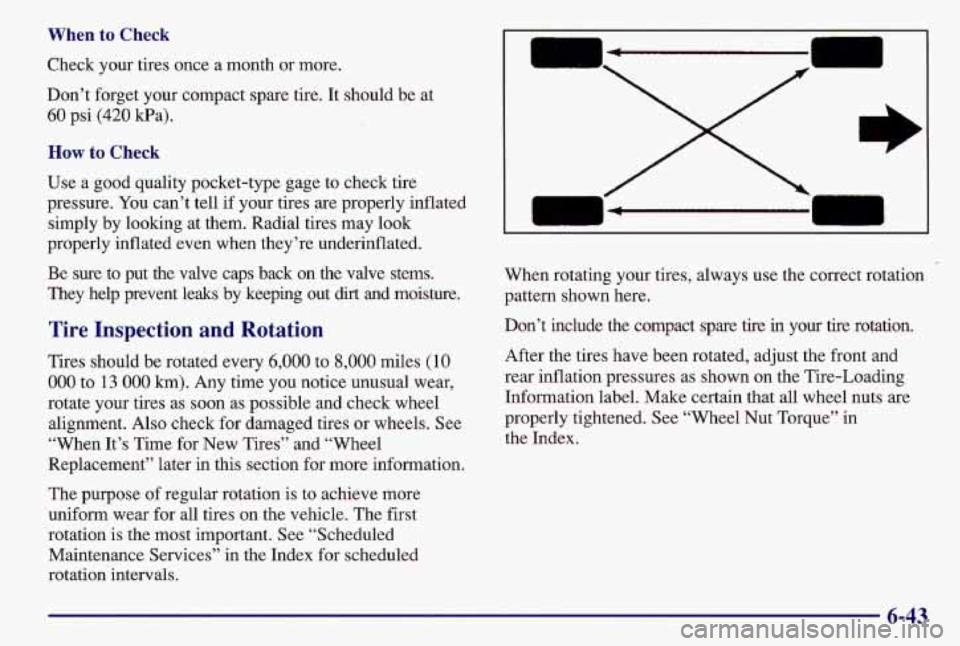
When to i- -- ~
Check your tires once a month or more.
Don’t forget your compact spare tire. It should be at
60 psi (420 Pa).
How to Check
Use a good quality pocket-type gage to check tire
pressure.
You can’t tell if your tires are properly inflated
simply by looking at them. Radial tires may look
properly inflated even when they’re underinflated.
Be sure to put the valve caps back on the valve stems.
.They help prevent leaks by keeping out dirt and moisture.
Tire Inspection and Rotation
Tires should be rotated every 6,000 to 8,000 miles (10
000 to 13 000 km). Any time you notice unusual wear,
rotate your tires as soon as possible and check wheel
alignment. Also check for damaged tires or wheels. See
“When It’s Time for New Tires” and “Wheel
Replacement” later in this section for more information.
The purpose of regular rotation
is to achieve more
uniform wear for all tires on the vehicle. The first
rotation is the most important. See “Scheduled
Maintenance Services’’ in the Index for scheduled
rotation intervals.
0
I
When rotating your tires, always use the correct rotation
pattern shown here.
Don’t include the compact spare tire
in your tire rotation.
After the tires have been rotated, adjust the front
and
rear inflation pressures as shown on the Tire-Loading
Information label. Make certain that all wheel nuts are
properly tightened. See “Wheel Nut Torque” in
the Index.
6-43